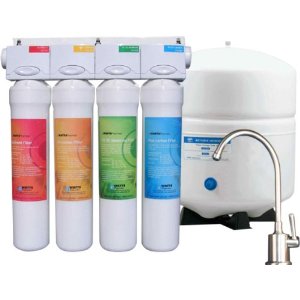I have very hard water (TDS 500-700) and use this Watts RO filter

For fun I decided to send my RO water to Ward Labs to confirm it's doing a good job. Here's the results:
pH 6.6
Total Dissolved Solids (TDS) Est, ppm 59
Electrical Conductivity, mmho/cm 0.10
Cations / Anions, me/L 0.8 / 0.7
ppm
Sodium, Na 15
Potassium, K < 1
Calcium, Ca 1
Magnesium, Mg < 1
Total Hardness, CaCO3 7
Nitrate, NO3-N 0.2 (SAFE)
Sulfate, SO4-S < 1
Chloride, Cl 20
Carbonate, CO3 < 1.0
Bicarbonate, HCO3 4
Total Alkalinity, CaCO3 3
Total Phosphorus, P 0.01
Total Iron, Fe < 0.01
"<" - Not Detected / Below Detection Limit
So a lot more sodium and chloride than I expected, but everything else looks low. Since this is a pretty popular RO system I thought a few of you might be interested in this.

For fun I decided to send my RO water to Ward Labs to confirm it's doing a good job. Here's the results:
pH 6.6
Total Dissolved Solids (TDS) Est, ppm 59
Electrical Conductivity, mmho/cm 0.10
Cations / Anions, me/L 0.8 / 0.7
ppm
Sodium, Na 15
Potassium, K < 1
Calcium, Ca 1
Magnesium, Mg < 1
Total Hardness, CaCO3 7
Nitrate, NO3-N 0.2 (SAFE)
Sulfate, SO4-S < 1
Chloride, Cl 20
Carbonate, CO3 < 1.0
Bicarbonate, HCO3 4
Total Alkalinity, CaCO3 3
Total Phosphorus, P 0.01
Total Iron, Fe < 0.01
"<" - Not Detected / Below Detection Limit
So a lot more sodium and chloride than I expected, but everything else looks low. Since this is a pretty popular RO system I thought a few of you might be interested in this.

